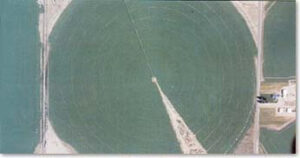 High Altitude Potato Farming
High Altitude Potato Farming
Monte Vista, Colorado
Crisp, good-tasting potatoes are the main cash crop of south central Colorado’s San Luis Valley. Over 60,000 acres are planted to take advantage of the valley’s fertile soil, warm summer days, cool nights, and plentiful water supply. Farming in this region is not without its challenges, however. The valley floor ranges from 7,000 to 8,000 feet in altitude and is surrounded by mountains – some reaching more than 14,000 feet. As a result, the growing season only averages about 100 days and, in many years, is considerably shorter.
Sanderson Farms is a third generation family-owned operation which has developed expert potato-growing techniques in response to local conditions. Headed up by CEO Jim Sanderson, the operation extends over 1350 acres of which 860 acres are dedicated to potatoes and the balance is used to grow malt barley and wheat. “Currently we are growing three varieties of potatoes – Norkotas, Nuggets, and Sangre Reds,” says Ken Stoeber, Farm Operations Manager. “Our total production averages about 300,000 cwt. (15,241 tonnes) per year.”
Sanderson’s farming operation is handled by five year-round employees with 20 – 25 extra hands being taken on at harvest time. An additional 32 workers are employed in the warehouse operation. “We not only package our own product but also process an additional 600-700,000 cwt. (30,481 – 35,561 tonnes) from neighbouring farms,” explains John Bradshaw, Manager of Warehouse Operations. Potatoes are washed, inspected, bagged, stored and then shipped all over the United States from the middle of September to July of the following year.
Running an operation such as Sanderson Farms requires a considerable investment in equipment. “We have four John Deere tractors plus all the implements needed for digging and harvesting; ten potato trucks for harvesting; five pick-up trucks, and several expensive hydraulic pumps and hydraulic motors,” says Ken. “Anything that can help prevent metal to metal contact and reduce friction and wear is of great interest to us!”
Keeping their bearings
“The shortness of the growing season in the San Luis Valley means we have to try and make our harvesting as efficient and problem-free as possible,” says Sanderson’s Ken Stoeber. “We need to have all the potatoes out of the ground by October 10th. If we have experienced any set-backs with the weather in the spring and summer months, then the pressure is really on.”
Taking care of the bearings on the farm’s diggers and harvesters is a top priority. According to Ken, each piece of equipment has between 2 and 45 bearings costing anywhere between $20 to $200, or more, in the case of fan bearings. Should a bearing go down, however, the cost of replacement pales in comparison with the losses in precious time and manpower. “Downtime is a real killer especially when you have 20 to 25 extra hands standing around while the equipment is being fixed.”
Since Sanderson Farms started using Power Up’s Thixogrease, they have not experienced any bearing failures on their diggers and harvesters. Another product they rely on is RCL 1000. “Roller chains on the diggers and harvesters used to be a big problem,” says Ken. “They get very hot and the bearings are high speed. Chains just don’t last; some farmers even run them dry because most lubes will attract a lot of dirt. But we have found that RCL 1000 works like no other chain lube. It keeps our chains and bearings much cooler so we know we are preventing wear. The chains actually stay shiny – even after they have sat outside all winter!”
NNL 690 has performed well in Sanderson’s warehouse operation. Manager John Bradshaw has noticed a considerable reduction in running temperatures since he started using the product in his hydraulic pumps and motors. “We are experiencing far fewer leaks because our hoses are not getting hot and becoming brittle,” says John.
The most dramatic results Sanderson Farms have experienced with Power Up’s NNL-690, though, has been with a 6 cylinder Ford Diesel Generator that is used to unload potatoes to the cellar for storage. “One day it had an oil line break,” says Ken. “We don’t know how long it ran before we noticed the problem, but the oil – all 9 gallons (34 liters) of it – had completely soaked into the ground. Amazingly enough, the motor was still running and felt cool to the touch. Wanting to know for sure it was O.K., we pulled the pan. We were surprised to find no metal shavings. In fact, there was no damage to the crank or anywhere else. The only repair made to this motor was to the oil line and, to this day, it has not used a drop of oil and is still running with the same compression it always had. Power Up saved us $8,000!”
